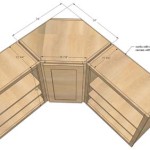How Much Space Is Required Between a Kitchen Island and Cabinets/Counter
The kitchen island has become a staple in modern home design, offering additional workspace, storage, and a central gathering point. However, the functionality and aesthetic appeal of a kitchen island are heavily dependent on its size and, crucially, the surrounding space. The distance between the island and the adjacent cabinets and countertops is a critical factor that dictates traffic flow, ease of use, and overall kitchen ergonomics. Insufficient space can lead to a cramped and frustrating cooking environment, while excessive space can make navigating the kitchen inefficient. This article will explore the optimal spacing requirements between a kitchen island and the surrounding cabinetry and countertops, considering various factors that influence these dimensions.
Achieving the right balance ensures a comfortable and functional kitchen layout. This involves meticulous planning and consideration of individual needs and preferences. While there are general guidelines, the ideal spacing can vary based on the kitchen's size, the island's dimensions, and the activities typically performed in the space. Overlooking this crucial aspect can result in a kitchen that is visually appealing but ultimately impractical for daily use.
Understanding the Importance of Adequate Spacing
The space between a kitchen island and the surrounding counters and cabinets, often referred to as "walkways," is not merely an aesthetic consideration. It fundamentally impacts the usability and efficiency of the kitchen. Adequate walkways allow for comfortable movement, prevent bottlenecks, and facilitate simultaneous use by multiple individuals. Without sufficient space, tasks such as opening appliance doors, navigating with hot dishes, or simply passing by someone working at the island become cumbersome and potentially hazardous.
A well-planned spacing arrangement contributes to a safer kitchen environment. It minimizes the risk of collisions, especially when carrying heavy or hot items. Furthermore, it allows for wheelchair accessibility, catering to individuals with mobility challenges. By prioritizing sufficient walkways, the kitchen becomes a more inclusive and user-friendly space for everyone.
Ergonomics plays a vital role in determining optimal spacing. A kitchen designed with adequate walkways reduces strain and fatigue associated with cooking and other kitchen activities. It allows for natural and fluid movements, minimizing the need to squeeze through tight spaces or reach awkwardly. This, in turn, enhances the overall cooking experience and makes the kitchen a more enjoyable space to be in.
Recommended Clearance Dimensions: The 42-inch Rule
The generally accepted standard for walkway clearance in a kitchen is a minimum of 42 inches. This measurement refers to the clear, unobstructed space between the edge of the island countertop and the edge of the adjacent cabinet or appliance. This 42-inch clearance allows for one person to comfortably work in the space or allows another person to easily pass by. This measurement also allows for full extension of dishwasher doors without blocking the pathway.
While 42 inches is a commonly cited guideline, it's essential to recognize that this is a minimum recommendation. In kitchens where two or more individuals frequently work simultaneously, or where appliances such as refrigerators or ovens are located along the walkway, a larger clearance of 48 inches or more may be preferable. This extra space allows for greater freedom of movement and reduces the likelihood of collisions when navigating the kitchen.
In small kitchens with limited space, achieving a full 42-inch clearance on all sides of the island may not be feasible. In such cases, careful consideration should be given to prioritizing the most heavily trafficked areas. For example, the walkway between the island and the primary cooking zone (stove, oven, sink) should ideally maintain the recommended clearance, while less frequently used areas may be slightly narrower (though never falling below 36 inches, which is considered the absolute minimum for a single person to pass through).
Factors Influencing Spacing Requirements
Several factors beyond the basic 42-inch guideline can influence the optimal spacing between a kitchen island and surrounding cabinetry. These include the size and shape of the island, the presence of appliances, the number of users, and the overall kitchen layout.
Island Size and Shape:
Larger islands naturally require more surrounding space to maintain comfortable walkways. Consider the island's overhang; a larger overhang for seating requires more space behind it. The shape of the island also plays a role; an irregularly shaped island might create pinch points or awkward angles that necessitate adjustments to the surrounding clearance.Appliance Placement:
The location of major appliances, particularly refrigerators, dishwashers, and ovens, significantly impacts spacing requirements. These appliances require sufficient clearance for door swing and access. For instance, a refrigerator with a French door configuration may require less clearance than a side-by-side model. The swing of appliance doors should be carefully considered when determining the optimal walkway width. The 42 inch space takes into account the clearance needed to open dishwasher doors sufficiently to load and unload efficiently.Number of Users:
A kitchen designed for a single cook will have different spatial requirements than one intended for multiple users. If two or more individuals frequently work in the kitchen simultaneously, wider walkways are essential to prevent congestion and ensure comfortable movement. Consider the typical workflow and how multiple users might interact with the island and surrounding areas.Kitchen Layout:
The overall layout of the kitchen also influences spacing needs. In a galley kitchen, where cabinets and appliances line two opposing walls, the space between them must be carefully planned to ensure efficient workflow. Similarly, in an L-shaped or U-shaped kitchen, the placement of the island and its relationship to the surrounding counters will dictate the optimal walkway width.Furthermore, consider the style of the kitchen and the overall aesthetic. A modern, minimalist kitchen might benefit from wider, more open walkways, while a traditional kitchen might have a more compact layout. The spacing should complement the overall design and create a cohesive and functional space.
Practical Considerations for Planning and Implementation
When planning the spacing between a kitchen island and surrounding cabinetry, it is important to adopt a systematic approach that considers both functional and aesthetic needs. This involves careful measurement, layout planning, and real-world simulation to ensure the final result is both practical and visually appealing.
Accurate Measurement:
Begin by accurately measuring the kitchen dimensions, including the length and width of the space, the location of existing cabinets and appliances, and the desired size and shape of the island. Precise measurements are crucial for creating a realistic layout plan and avoiding costly mistakes.Layout Planning:
Use graph paper or specialized kitchen design software to create a scaled layout of the kitchen. Experiment with different island sizes and positions to determine the optimal placement that maximizes workspace and minimizes congestion. Pay close attention to walkway widths and appliance clearance, ensuring that all areas are easily accessible and functional.Real-World Simulation:
Once you have a preliminary layout, simulate the kitchen environment in the actual space. Use tape or cardboard to mark out the island's dimensions and the surrounding walkways. Walk through the space, performing typical kitchen tasks, such as opening appliance doors, reaching for cookware, and navigating with hot dishes. This will help identify any potential bottlenecks or awkward areas that need to be addressed. Many home improvement stores have virtual reality aids to make the process easier.Consultation with Professionals:
Consider consulting with a kitchen designer or contractor to review your layout plan and provide expert advice. These professionals have extensive experience in kitchen design and can offer valuable insights into optimizing space and functionality. They can also help identify potential challenges and suggest creative solutions that you may not have considered.Accessibility Considerations:
If anyone in the household has mobility challenges, it is essential to incorporate accessibility considerations into the kitchen design. This may involve widening walkways, lowering countertop heights, and providing ample clearance around appliances and sinks. Ensure that the kitchen is designed to be inclusive and user-friendly for everyone.By adopting a systematic approach to planning and implementation, one can ensure that the spacing between a kitchen island and surrounding cabinetry is optimized for both functionality and aesthetics. A well-planned kitchen is not only visually appealing but also a comfortable and efficient space that enhances the overall cooking experience.
In conclusion, determining the appropriate spacing between a kitchen island and its surrounding elements is a nuanced process that requires careful consideration of various factors. While the 42-inch minimum guideline serves as a helpful starting point, the optimal dimensions can vary based on island size and shape, appliance placement, user needs, and the overall kitchen layout. By carefully evaluating these factors and consulting with professionals when needed, homeowners can create a kitchen that is both beautiful and highly functional.

All Standard Dimensions For N Kitchen You Need To Know

10 Kitchen Space Rules To Follow Immediately For A Phenomenal Set Up Arch2o Com

Do I Have Room For A Kitchen Island Houzz Ie

What Is Too Much Space Between Kitchen Island And Counters

How Much Space Between Oven And Kitchen Island

How Big Should A Kitchen Be For An Island Plus More Flipping Prosperity

Kitchen Cabinet Measurements Clearances Kadilak Homes

4 Important Tips To Choose Kitchen Island Size Fit Your Need

Does My Kitchen Have Enough Space For An Island Rwc

Minimum Walking Space For Kitchens
Related Posts








